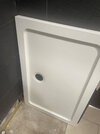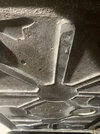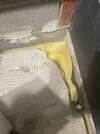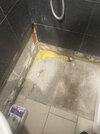Hi,
I recently moved to a flat where the shower tray wasn't very well installed and was leaking. I have had to remove the shower tray (and some of the tiles) to get access to the waste. I need to get it installed and working soon but unfortunately don't have enough money to replace everything. The shower tray looks fine so I'm hoping to reinstall it, and as I have never tiled before, I thought it might be safest to use some kind of wall board instead.
I have attached some photos of the tray and shower area, hopefully you'll be able to give me some suggestions and answer the following questions:
Plastic Feet vs sand/cement? There are no markings on the shower tray, so I can't check the manufacturers instructions: am I safe to use sand and cement then bed the tray on top or should I use plastic feet? The tray was originally installed with plastic feet, but it never felt very stable and was quite noisy as a result, so I'm quite keen to use the (better?) option of sand/cement if its suitable?
I had to chisel-away the floor in the corner to get access to the soil pipe, should I do anything to prepare or repair the floor before installing the tray? I'd like to get the tray as close to the floor as possible. There seems to be a solid concrete floor, then a floating concrete floor above, I'm not sure what this kind of construction is called? Is there anything I need to be careful about or aware of? (Also, in the future, will it be possible to remove the "floating" sub-floor and just install a flush tray that will be flush with the surrounding floor tiles?)
Which way round should the tray go? Am I best/safe to orientate it with the trap closest to be back wall, which is where the soil pipe is located.
After installing the tray and waste, can I just install some kind of plastic wall board up to the top of the tray and bond it to the existing tiles? I'd like to do a better job, but can't really afford to rip-out the tiles and plasterboard and start again right now, what do you think? I presume that I should plasterboard the bottom of the wall where the tiles are missing to give some support to the wall panels? Then I can just seal the tray with silicone? I'm not against using tiles or something else, but don't really have the experience and I'm guessing it'll cost more to strip everything back to the breeze blocks?
Hopefully thats all clear, thanks for your help!
I recently moved to a flat where the shower tray wasn't very well installed and was leaking. I have had to remove the shower tray (and some of the tiles) to get access to the waste. I need to get it installed and working soon but unfortunately don't have enough money to replace everything. The shower tray looks fine so I'm hoping to reinstall it, and as I have never tiled before, I thought it might be safest to use some kind of wall board instead.
I have attached some photos of the tray and shower area, hopefully you'll be able to give me some suggestions and answer the following questions:
Plastic Feet vs sand/cement? There are no markings on the shower tray, so I can't check the manufacturers instructions: am I safe to use sand and cement then bed the tray on top or should I use plastic feet? The tray was originally installed with plastic feet, but it never felt very stable and was quite noisy as a result, so I'm quite keen to use the (better?) option of sand/cement if its suitable?
I had to chisel-away the floor in the corner to get access to the soil pipe, should I do anything to prepare or repair the floor before installing the tray? I'd like to get the tray as close to the floor as possible. There seems to be a solid concrete floor, then a floating concrete floor above, I'm not sure what this kind of construction is called? Is there anything I need to be careful about or aware of? (Also, in the future, will it be possible to remove the "floating" sub-floor and just install a flush tray that will be flush with the surrounding floor tiles?)
Which way round should the tray go? Am I best/safe to orientate it with the trap closest to be back wall, which is where the soil pipe is located.
After installing the tray and waste, can I just install some kind of plastic wall board up to the top of the tray and bond it to the existing tiles? I'd like to do a better job, but can't really afford to rip-out the tiles and plasterboard and start again right now, what do you think? I presume that I should plasterboard the bottom of the wall where the tiles are missing to give some support to the wall panels? Then I can just seal the tray with silicone? I'm not against using tiles or something else, but don't really have the experience and I'm guessing it'll cost more to strip everything back to the breeze blocks?
Hopefully thats all clear, thanks for your help!





